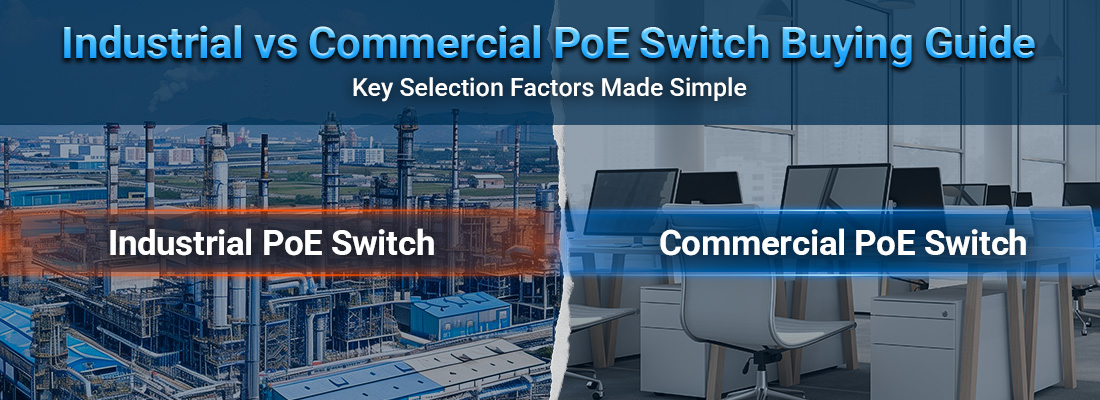
For network infrastructure planners and engineers, selecting between industrial and commercial Power over Ethernet (PoE) switches requires careful consideration of fundamental operational differences. While commercial PoE switches serve adequately in climate-controlled offices, industrial PoE switches are engineered to withstand extreme conditions while delivering reliable power and data transmission. This guide examines the key selection factors to optimize your network investment based on the specific deployment environment and performance requirements.
Environmental Durability and Operating Conditions
The operating environment constitutes the primary differentiator between industrial and commercial switch deployments. Industrial PoE switches are purpose-built for harsh conditions, featuring wide temperature tolerances from -40°C to 75°C, significantly broader than commercial counterparts . They boast superior physical protection with IP40 or higher ratings, effectively resisting dust, moisture, and corrosion that would quickly disable standard commercial switches . Additionally, industrial switches demonstrate enhanced electromagnetic compatibility (EMC), maintaining signal integrity in high-interference environments common in manufacturing facilities, power plants, and transportation systems . These rugged characteristics ensure continuous operation where commercial switches would succumb to environmental stressors, making them essential for outdoor installations, industrial automation, and critical infrastructure applications.
Performance Specifications and Power Delivery
When evaluating PoE switches, both data throughput and power delivery capabilities must align with connected device requirements. Commercial-grade PoE switches typically adhere to standard IEEE 802.3af/at specifications, delivering up to 30W per port . However, industrial PoE switches often support higher power budgets and specialized protocols for industrial applications. Key performance considerations include port density (4-48 ports), transmission rates (10/100/1000Mbps or multi-gigabit), and PoE budget allocation . For instance, the Alcatel-Lucent Enterprise OS6360-P24 offers 24 PoE+ ports with a 180W total budget, while Allied Telesis GS980MX系列 models support up to 90W PoE++ for high-power devices like PTZ cameras with heating elements . Understanding both current and future power requirements prevents under-specification, ensuring adequate capacity for all connected endpoints without exceeding thermal limitations.
Reliability Features and Network Redundancy
Network reliability demands vary significantly between commercial and industrial environments. While commercial installations prioritize cost-effectiveness and simplicity, industrial applications necessitate robust redundancy mechanisms and fault tolerance. Industrial PoE switches incorporate dual power inputs and ring network protocols like ERPS or RSTP with sub-50ms recovery times, preventing single points of failure from crippling operations . These switches utilize industrial-grade components including wide-temperature chips and solid-state capacitors that withstand vibration, shock, and extended temperature cycling . Such design considerations translate to mean time between failures (MTBF) rates dramatically higher than commercial equivalents in demanding conditions. For mission-critical applications in energy, transportation, or manufacturing, these reliability features justify the premium associated with industrial-grade networking equipment.
Protocol Support and Management Capabilities
The divergence in protocol support and management features between commercial and industrial PoE switches reflects their different operational contexts. Commercial switches typically emphasize plug-and-play functionality with limited management options, suitable for standard office networks . Conversely, industrial managed switches support industrial Ethernet protocols like PROFINET, EtherNet/IP, and Modbus TCP, enabling seamless integration with PLCs, sensors, and control systems . Advanced management functionalities including VLAN segmentation, Quality of Service (QoS) prioritization, and port mirroring provide granular control over network traffic . The DGS-1000 Series from D-Link, for example, offers PoE usage monitoring and configuration DIP switches for field adjustments . These capabilities ensure deterministic communication and simplified troubleshooting essential for industrial automation while maintaining compatibility with existing business networks.
Application-Specific Selection Recommendations
Choosing between industrial and commercial PoE switches ultimately depends on deployment scenarios and performance expectations. Commercial PoE switches from brands like D-Link and TP-Link serve effectively for office wireless access points, VoIP phones, and surveillance cameras in controlled environments . Their cost-efficient design meets typical enterprise needs without unnecessary ruggedization. Conversely, select industrial PoE switches from manufacturers like Allied Telesis, Alcatel-Lucent Enterprise, or Hirschmann for harsh environments like factory floors, outdoor installations, or critical infrastructure . These applications benefit from specialized features like Power over Ethernet (PoE)+ capabilities, fiber optic connectivity, and compliance with industry-specific standards such as IEC 61850 for electrical substations . Carefully match switch specifications to environmental challenges and connectivity demands to optimize both upfront investment and long-term operational reliability.
Conclusion
The decision between industrial and commercial PoE switches significantly impacts network reliability, maintenance costs, and system longevity. Industrial PoE switches deliver superior environmental hardening, redundancy, and protocol support for demanding applications, while commercial PoE switches provide cost-effective connectivity for benign office environments. By critically evaluating environmental conditions, performance requirements, reliability needs, and management capabilities, network professionals can specify the appropriate switch category that balances operational requirements with budget constraints. As industrial IoT continues to expand, understanding these selection factors becomes increasingly crucial for building resilient, high-performance networks that support both current operations and future expansion.